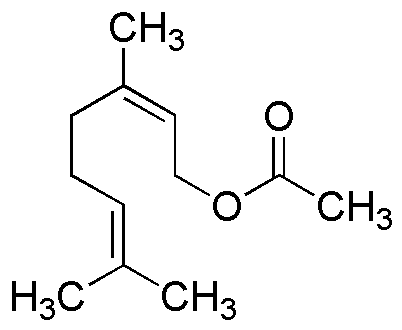Neryl acetate is widely utilized in research focused on:
- Fragrance Industry: This compound is a key ingredient in perfumes and cosmetics, providing a fresh, fruity aroma that enhances product appeal.
- Flavoring Agent: It is commonly used in the food industry to impart a citrus-like flavor to various products, making it popular in candies, beverages, and baked goods.
- Pharmaceuticals: Neryl acetate serves as a potential therapeutic agent, being investigated for its anti-inflammatory and antimicrobial properties, which could lead to new drug formulations.
- Aromatherapy: In essential oils, it is valued for its calming scent, contributing to stress relief and relaxation in wellness products.
- Biopesticides: This compound is explored for its natural insect-repelling qualities, offering an eco-friendly alternative in agriculture to protect crops from pests.
General Information
Properties
Safety and Regulations
Applications
Neryl acetate is widely utilized in research focused on:
- Fragrance Industry: This compound is a key ingredient in perfumes and cosmetics, providing a fresh, fruity aroma that enhances product appeal.
- Flavoring Agent: It is commonly used in the food industry to impart a citrus-like flavor to various products, making it popular in candies, beverages, and baked goods.
- Pharmaceuticals: Neryl acetate serves as a potential therapeutic agent, being investigated for its anti-inflammatory and antimicrobial properties, which could lead to new drug formulations.
- Aromatherapy: In essential oils, it is valued for its calming scent, contributing to stress relief and relaxation in wellness products.
- Biopesticides: This compound is explored for its natural insect-repelling qualities, offering an eco-friendly alternative in agriculture to protect crops from pests.
Documents
Safety Data Sheets (SDS)
The SDS provides comprehensive safety information on handling, storage, and disposal of the product.
Product Specification (PS)
The PS provides a comprehensive breakdown of the product’s properties, including chemical composition, physical state, purity, and storage requirements. It also details acceptable quality ranges and the product's intended applications.
Certificates of Analysis (COA)
Search for Certificates of Analysis (COA) by entering the products Lot Number. Lot and Batch Numbers can be found on a product’s label following the words ‘Lot’ or ‘Batch’.
*Catalog Number
*Lot Number
Certificates Of Origin (COO)
This COO confirms the country where the product was manufactured, and also details the materials and components used in it and whether it is derived from natural, synthetic, or other specific sources. This certificate may be required for customs, trade, and regulatory compliance.
*Catalog Number
*Lot Number
Safety Data Sheets (SDS)
The SDS provides comprehensive safety information on handling, storage, and disposal of the product.
DownloadProduct Specification (PS)
The PS provides a comprehensive breakdown of the product’s properties, including chemical composition, physical state, purity, and storage requirements. It also details acceptable quality ranges and the product's intended applications.
DownloadCertificates of Analysis (COA)
Search for Certificates of Analysis (COA) by entering the products Lot Number. Lot and Batch Numbers can be found on a product’s label following the words ‘Lot’ or ‘Batch’.
*Catalog Number
*Lot Number
Certificates Of Origin (COO)
This COO confirms the country where the product was manufactured, and also details the materials and components used in it and whether it is derived from natural, synthetic, or other specific sources. This certificate may be required for customs, trade, and regulatory compliance.


